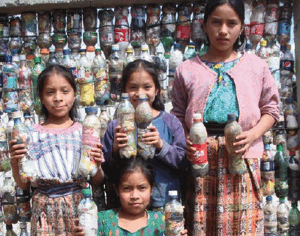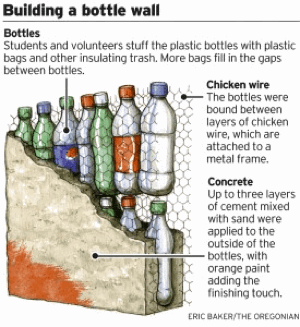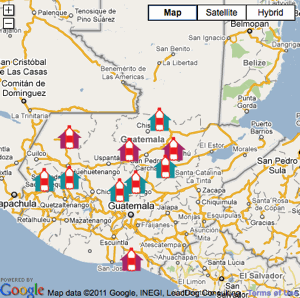Trash to Treasure
Air Date: Week of February 11, 2011

Students in Guatemala showing their hard work. (Photo: Hug it Forward)
In rural Guatemala, communities are working together to collect trash and plastic bottles to use as building materials. Former Peace Corp volunteer Laura Kutner tells host Bruce Gellerman that projects like this are a win-win: villages are cleaner and children get new schools.
Transcript
GELLERMAN: ItÂ’s Living on Earth, IÂ’m Bruce Gellerman. There are ships IN bottles. Now, there are schools OUT of bottles. In Grenados, Guatemala, kids are learning the 3 RÂ’s - reading, writing and recycling. TheyÂ’ve learned how to turn plastic bottles into walls for their schools. Laura Kutner from Portland, Oregon helped make it happen. She recently returned from Grenados in central Guatemala where she served in the Peace Corps.
A video of children in Guatemala building a school from bottles.
KUTNER: When I first arrived, I was working in the mornings with this elementary school, and there was this metal frame that was just sitting there. And, the principal asked me, she said, "Can you help us find funding to finish these two classrooms? This frame was built for two extra classrooms."
And I said, "Well, absolutely." And about that same time, I had heard about the work of a fellow volunteer. Basically, they turn plastic bottles and inorganic trash into building blocks. It was almost an accident - I was hanging out at recess with some of my students and I was drinking a Coca-Cola and it was in a 600mL bottle, and I realized that the bottle was the exact width of the metal frame that was sitting there.

Students in Guatemala showing their hard work. (Photo: Hug it Forward)
And so a little lightbulb went off in my head and I thought, well, maybe we could apply this construction technique of building out of bottles with this metal frame, and perhaps it will be, you know, a more cost-efficient way of finishing these classrooms.
GELLERMAN: Are these no-deposit, no-return bottles? Or are these bottles that you have a deposit and you get money for them?
KUTNER: Well, there’s no recycling system, unfortunately, in this part of the country. Guatemala as well as, you know, many countries around the world, has issues with waste management. There did exist the mentality of not being necessarily aware of how long it takes trash to decompose, and so a lot of times the plastic bottles and trash were just thrown on the ground – and it was just sitting there.
GELLERMAN: How many bottles did you have to collect?
KUTNER: We calculated that we needed to collect 6,000 bottles, but we ended up using over 8,000.
GELLERMAN: Whoo! ThatÂ’s a lot of bottles!
KUTNER: Yes. Lots of bottles.
GELLERMAN: WhereÂ’d you get them from?

Bottle building construction methods. (Photo: Hug it Forward)
KUTNER: We went to all of the local schools asking for their collaboration. So essentially, every student collected and stuffed at least five bottles. And these have to be stuffed to the max. They are called eco-bricks. And we walked around with the students and we literally cleaned the entire town. We picked up so much trash we had to go to neighboring suburbs to find more trash.
GELLERMAN: How much trash does this equate to?
KUTNER: Each bottle, and it varies a lot based on what kind of inorganic trash - all of the trash has to be inorganic. We had all of the local stores donate all of their plastic trash. You canÂ’t use any paper or cardboard because that decomposes quickly. You know, on average, a bottle weighs about a pound, so if youÂ…8,000 pounds is for one school.
GELLERMAN: So you picked up the bottles, you picked up the trash, you stuffed the trash into the bottles and then built a wall.
KUTNER: We built four walls. ItÂ’s a very simple process. Essentially, you have your frame, and you start on one side of the frame, you have to lay out eitherÂ…you know, you staple chicken wire to one side or what we did, because we used metal, was we tied with metal wire the chicken wire to one side first, and made it really, really tight.
And then you start on the inside and you are stacking the bottles against the first layer of chicken wire vertically and then horizontally, and then youÂ’re slowly closing it over with another layer of chicken wire and then tying both layers of chicken wire together.
So you kind of encage the bottles. And then you put three layers of cement on both sides. After that, you canÂ’t even tell that it was built out of bottles. It looks like it was built out of cement block.

A finished bottle school looks like any other cement building. (Photo: Hug it Forward)
GELLERMAN: Guatemala is a very active earthquake area - can these withstand earthquakes?
KUTNER: Absolutely. Because of the chicken wire and the way that itÂ’s built, itÂ’s actually a little more flexible in earthquake territory than cement block.
GELLERMAN: So whatÂ’s the potential for this kind of method in other parts of the world?
KUTNER: This has huge potential. Since our project has been completed, I have received email inquiries and questions from all over the world - from Haiti, from the Philippines, from Africa - people that are working and want to turn trash into building blocks.
But we always say that these projects, the actual structure - thatÂ’s just one aspect of it. The real long-term goal of these projects is the educational aspect to it, because this is not a long-term solution to trash management in any way, but just the educational aspect in learning how long it takes trash to decompose and what you can do with trash, and how much we produce. We produce enough trash to build buildings with it. And also, bringing communities togetherÂ…itÂ’s in every sense of the word, a win-win.

Locations of bottle schools in Guatemala. (Photo: Hug it Forward)
GELLERMAN: Well, Laura, thank you very much, really appreciate it.
KUTNER: Thank you for having me.
GELLERMAN: Laura Kutner recently returned from Grenados, Guatemala, where she served in the Peace Corps.
Links
Click here for more information on how you can donate to bottle schools in Guatemala.
Living on Earth wants to hear from you!
Living on Earth
62 Calef Highway, Suite 212
Lee, NH 03861
Telephone: 617-287-4121
E-mail: comments@loe.org
Newsletter [Click here]
Donate to Living on Earth!
Living on Earth is an independent media program and relies entirely on contributions from listeners and institutions supporting public service. Please donate now to preserve an independent environmental voice.
NewsletterLiving on Earth offers a weekly delivery of the show's rundown to your mailbox. Sign up for our newsletter today!
 Sailors For The Sea: Be the change you want to sea.
Sailors For The Sea: Be the change you want to sea.
 The Grantham Foundation for the Protection of the Environment: Committed to protecting and improving the health of the global environment.
The Grantham Foundation for the Protection of the Environment: Committed to protecting and improving the health of the global environment.
 Contribute to Living on Earth and receive, as our gift to you, an archival print of one of Mark Seth Lender's extraordinary wildlife photographs. Follow the link to see Mark's current collection of photographs.
Contribute to Living on Earth and receive, as our gift to you, an archival print of one of Mark Seth Lender's extraordinary wildlife photographs. Follow the link to see Mark's current collection of photographs.
 Buy a signed copy of Mark Seth Lender's book Smeagull the Seagull & support Living on Earth
Buy a signed copy of Mark Seth Lender's book Smeagull the Seagull & support Living on Earth

